Getac Technology AP6234M Tablet User Manual MX50
Getac Technology Corporation Tablet MX50
User Manual

Rugged Mobile Computing Solution
MX50
USER MANUAL

September 2016
Trademarks
Google and Android are trademarks of Google Inc.
The Bluetooth word mark and logos are owned by the Bluetooth SIG, Inc.
All other brand and product names are trademarks or registered trademarks
of their respective companies.
Disclaimer
Specifications and manuals are subject to change without notice. Getac
assumes no liability for damage incurred directly or indirectly from errors,
omissions, or discrepancies between the device and the manuals.
Notes
Depending on the specific model purchased, the color and look of your
device and accessories may not exactly match the graphics shown in this
document.
The screenshots and other presentations shown in this document are for
reference only. They may differ from the actual screens and presentations
generated by the actual product.
Your device is based on Google’s Android 5.1.1 operating system, with
additions by Getac.
For the latest version of the manual, please visit the Getac website
at www.getac.com..

i
Table of Contents
Chapter 1 Getting Started ................................................................. 1
Identifying Hardware Components .......................................... 1
Front Components ................................................................. 1
Back Components .................................................................. 2
Top Components .................................................................... 3
Right-Side Components ......................................................... 4
Getting Your Device Ready for Use .......................................... 5
Connecting to AC Power and Charging the Battery ........... 5
Performing the Initial Startup .............................................. 6
Using the Chest Mount .............................................................. 7
Chapter 2 Basic Skills ......................................................................... 9
Sleeping and Shutting Down .................................................... 9
Navigating on the Screen .......................................................... 9
Home Screen ............................................................................ 10
Extensions to the Home Screen .......................................... 11
Customizing Your Home Screen ......................................... 11
Using Applications ................................................................... 12
Navigation Bar ......................................................................... 12
Status Bar and Notifications Panel ......................................... 13
Quick Settings .......................................................................... 13
Entering Information ............................................................... 14
Chapter 3 Getting Connected ......................................................... 15
Wireless Connections ............................................................... 15
Using Wi-Fi Networks .......................................................... 15
Using the Bluetooth Function ............................................. 16
External Connections ............................................................... 17
Using a MicroSD Card .......................................................... 17
Connecting an Audio Device .............................................. 18
Connecting to a Computer via USB .................................... 19

ii
Chapter 4 Android Preinstalled Applications ................................ 20
Google Applications Overview ................................................ 20
Camera ...................................................................................... 22
Taking Pictures ..................................................................... 22
Taking Panoramic Pictures .................................................. 23
Shooting Videos ................................................................... 23
Chapter 5 Getac Applications ......................................................... 25
File Manager ............................................................................ 25
Button Descriptions ............................................................. 25
Opening a File ...................................................................... 26
GPS-ECompass .......................................................................... 27
Satellite Position .................................................................. 27
Electronic Compass .............................................................. 28
Location Information .......................................................... 29
Settings ................................................................................. 29
GPS Logging ......................................................................... 30
Chapter 6 Managing Your Device .................................................. 31
Managing Power ...................................................................... 31
Low Battery Signals and Actions ........................................ 31
Power-Saving Tips ................................................................ 32
Settings ..................................................................................... 33
Wireless and Networks Settings ......................................... 33
Device Settings ..................................................................... 34
Personal Settings ................................................................. 35
System Settings .................................................................... 35
Chapter 7 Care and Maintenance ................................................... 36
Resetting Your Device ............................................................. 36
Caring for Your Device ............................................................ 36
Chapter 8 Regulatory Information ................................................. 38
Regulations Statements ........................................................... 38
USA Class B Regulations ...................................................... 38
European Union CE Marking and Compliance Notices ..... 39
Safety Precautions .................................................................... 40
About Charging ................................................................... 40
About the AC Adapter ........................................................ 41

1
Chapter 1
Getting Started
This chapter introduces you to the external components of your device and
guides you through the process of setting up your device for use.
Identifying Hardware Components
Front Components
Ref Component Description
Power
connector
Connects to an external power source.
Touch screen Displays the output of your device and responds to
your touching.
Camera lens Takes still pictures or records video clips.
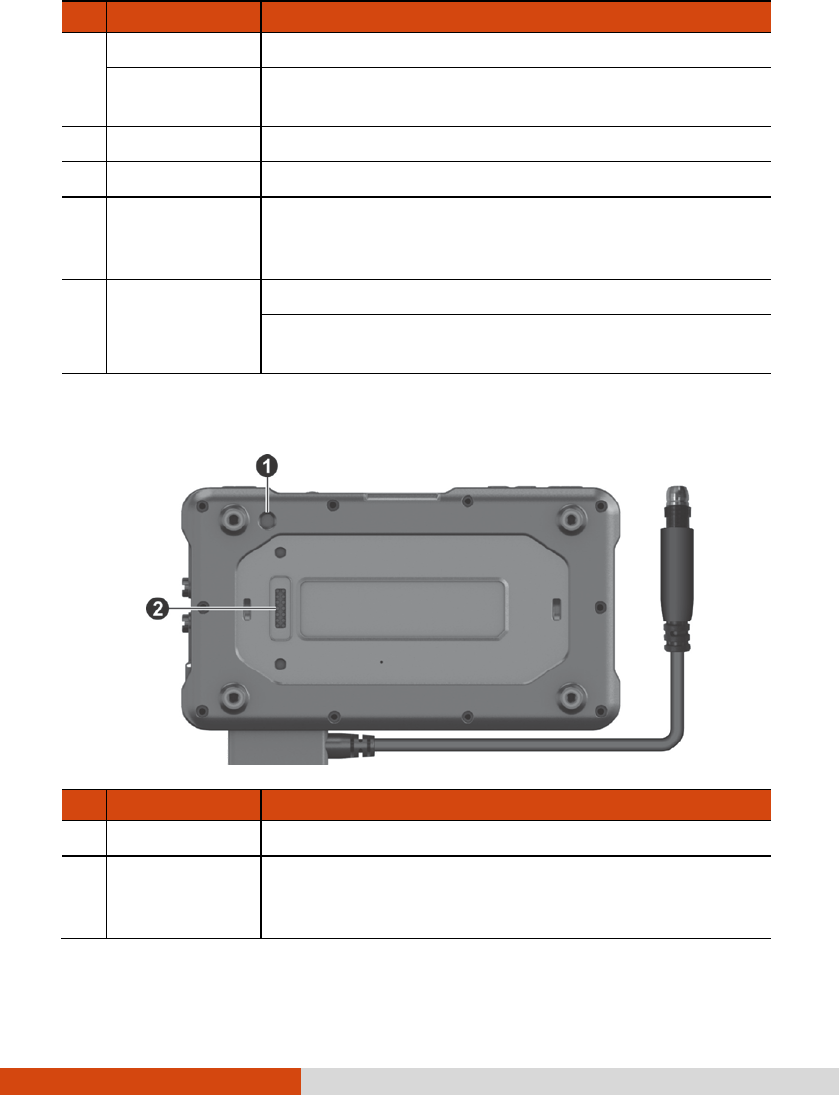
2
Ref Component Description
OK button Confirms your selection or input.
Arrow buttons Moves up, down, left and right within the screen or
menu.
Back button Goes back to the previous screen.
Home button Opens the Home screen.
Recent button Opens a screen containing thumbnails of applications
you’ve used recently. Touch a thumbnail to open that
application.
Fn quick
button
Opens the Camera application (default setting).
Can be assigned to a different function through
Settings.
Back Components
Ref Component Description
Camera lens Takes still pictures or records video clips.
Expansion
connector
(Pogo pin)
Connects to a proprietary snap-on module.
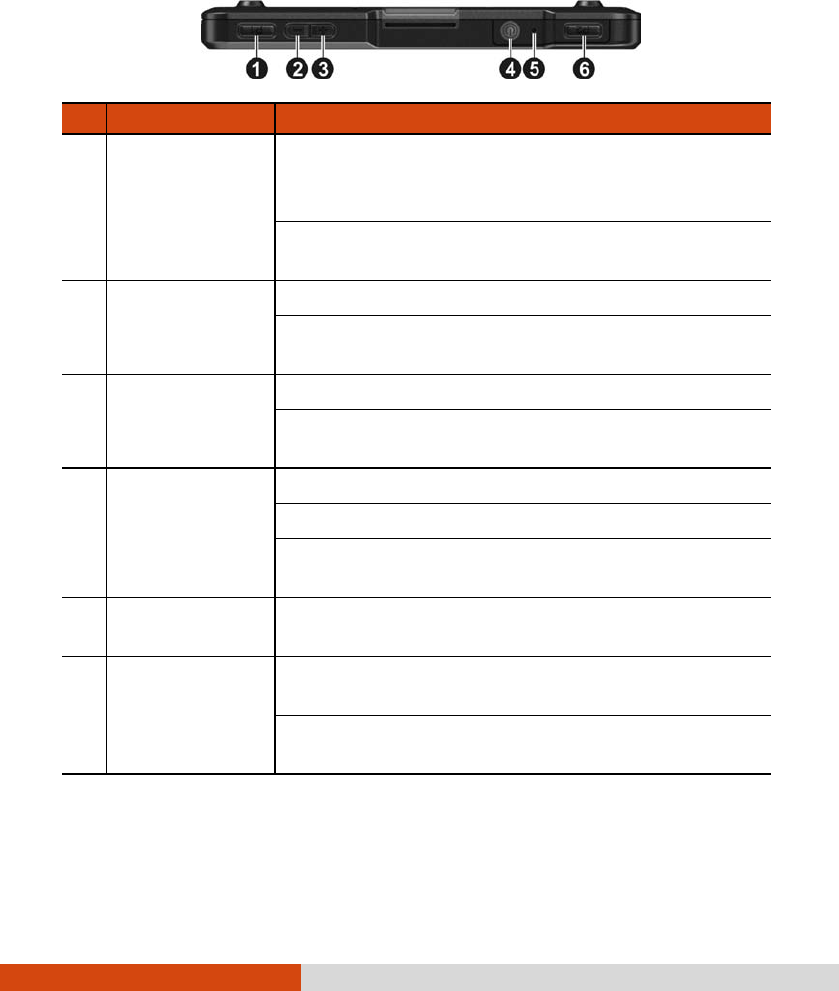
3
Top Components
Ref Component Description
P1 quick button Disables/enables the touch screen (default setting).
When disabled, you will see a frame around the
screen and a message at the bottom of the screen.
Can be assigned to a different function through
Settings.
Minus button Decreases the brightness level (default setting).
Can be assigned to a different function through
Settings.
Plus button Increases the brightness level (default setting).
Can be assigned to a different function through
Settings.
Power button Starts up the device.
Turns off or restores the screen.
When pressed longer:
Opens a menu with Power off option.
Reset switch Restarts your device when pressed for more than 5
seconds.
P2 quick button
Captures the current screen and saves it as an image
file (default setting).
Can be assigned to a different function through
Settings.
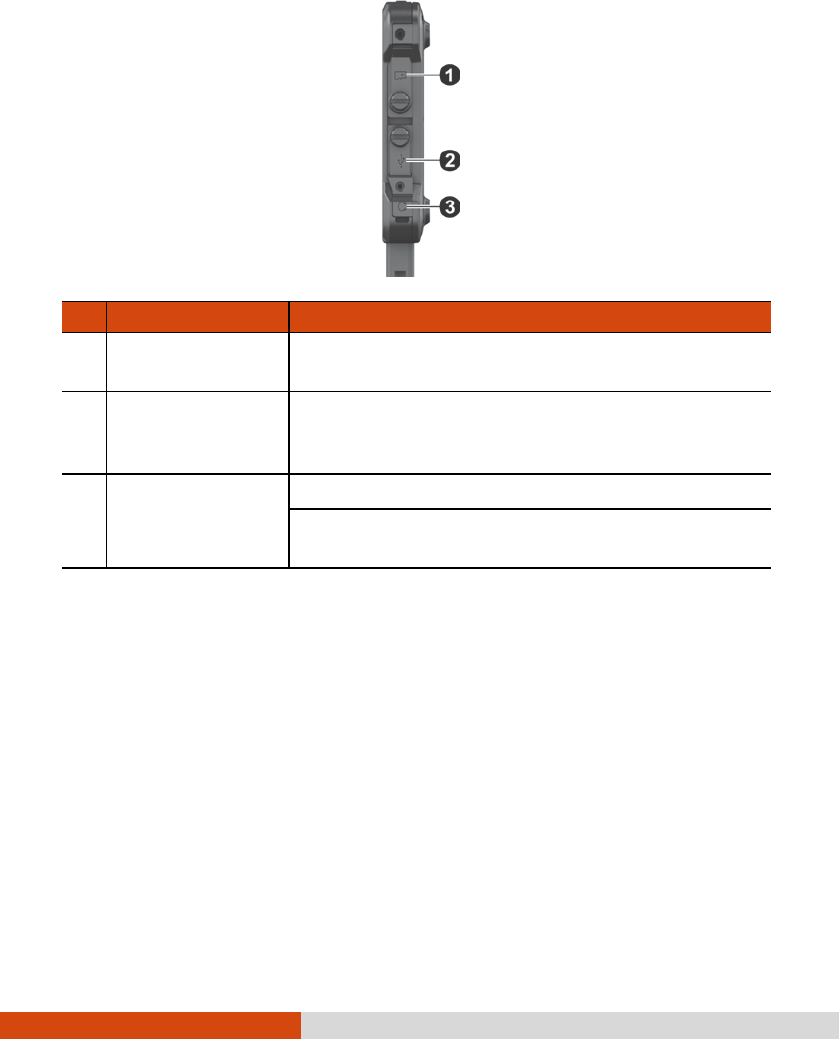
4
Right-Side Components
Ref Component Description
MicroSD card slot
(inside the cover)
Accepts a microSD card for removable storage.
Micro USB host
connector (inside
the cover)
Connects to a computer via USB cable for data
transfer.
Combo Audio
Connector
(inside
the cover)
Connects a set of headphones.
Supports a headset microphone with 4-pole TRRS
3.5mm jack.
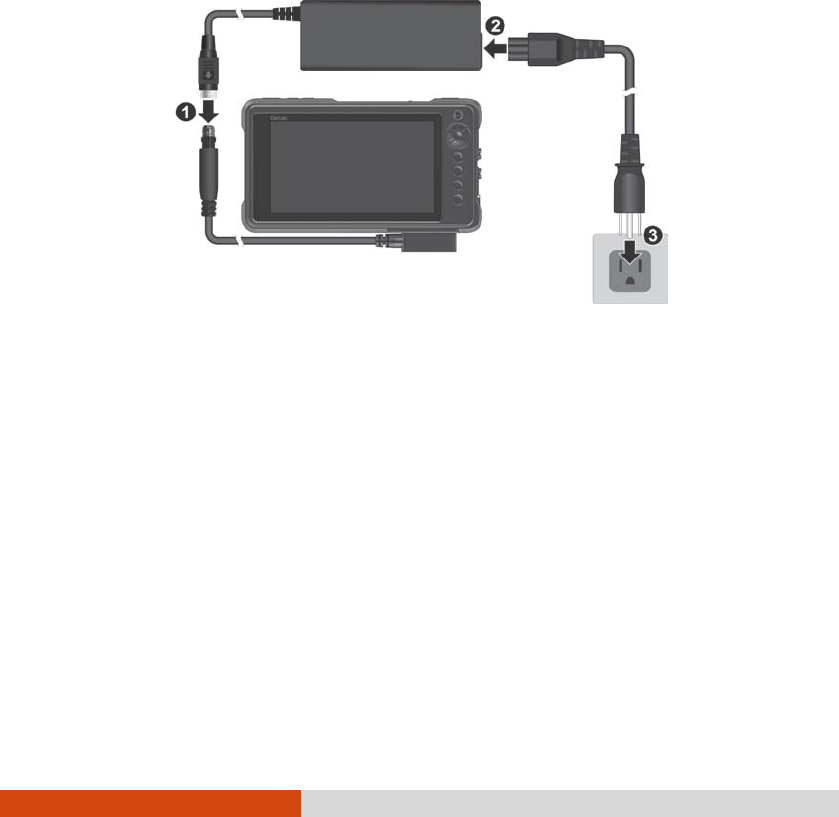
5
Getting Your Device Ready for Use
Connecting to AC Power and Charging the
Battery
1. Connect the AC adapter to the power connector of MX50 ().
Connect one end of the power cord to the AC adapter () and the other
end to an electrical outlet ().
NOTE: AC adapter and power cord types vary with countries.
2. Power is being supplied from the external power source to MX50.
When external power is connected, it also charges the internal battery.
For information on using battery power, see “Managing Power” in
Chapter 6.
CAUTION: For optimal performance of the lithium battery, take note of the
following:
Use the included AC adapter only.
There is no need to fully discharge the battery before charging. You can
charge the battery before it is discharged.
Do not charge the battery where the temperature is high (e.g. in direct
sunlight).

6
As a battery protection, store the device where the temperature is
appropriate. Avoid high temperatures.
The battery can be charged when its temperature is between 0°C (32°F)
and 40°C (104°F).
If you will not use the product for a long period of time, be sure to fully
charge the battery at least once every two weeks. Over discharge of the
battery can affect the charging performance.
Performing the Initial Startup
When turning on your device for the very first time, you will be guided
through a setup process.
1. Make sure that your device is either connected to AC power or the
battery has power.
2. Press the power button.
The device powers up and displays the initial screen.
3. Follow the on-screen instructions to complete the initial setup process.
After the setup is completed, the Home screen appears. You can now use
your device.
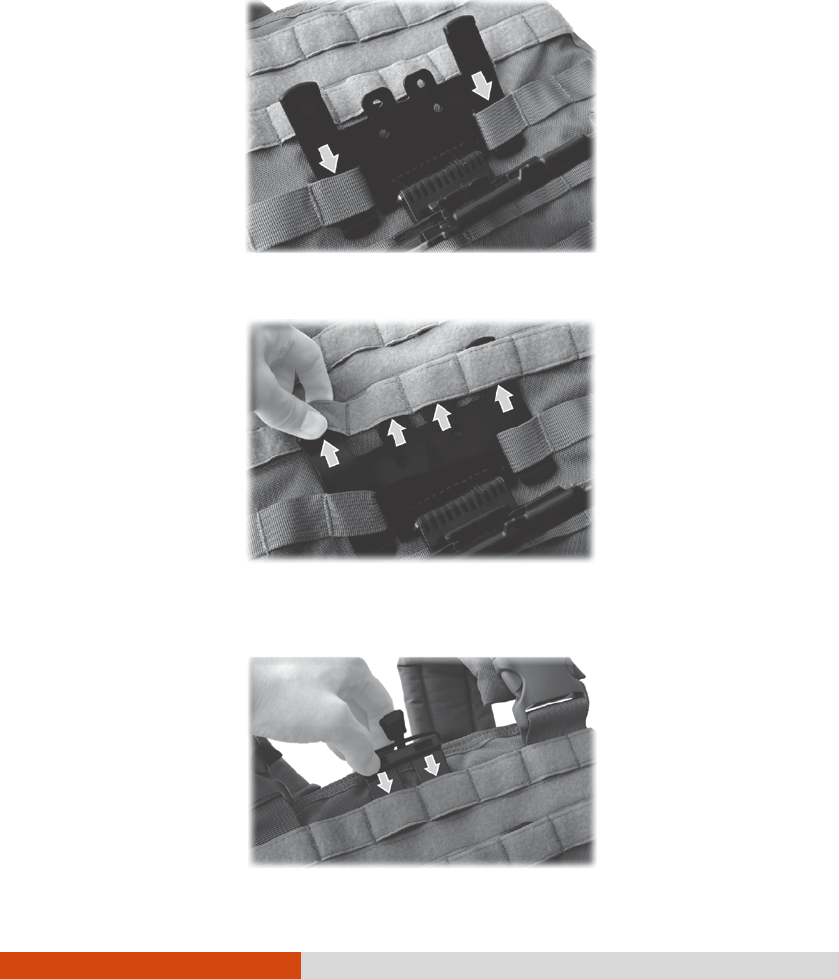
7
Using the Chest Mount
1. Feed the two lower tabs of the mount through lower webbing.
2. Feed all four top tabs through upper webbing.
3. Insert the retention-cord piece to the webbing above the center of the
mount.
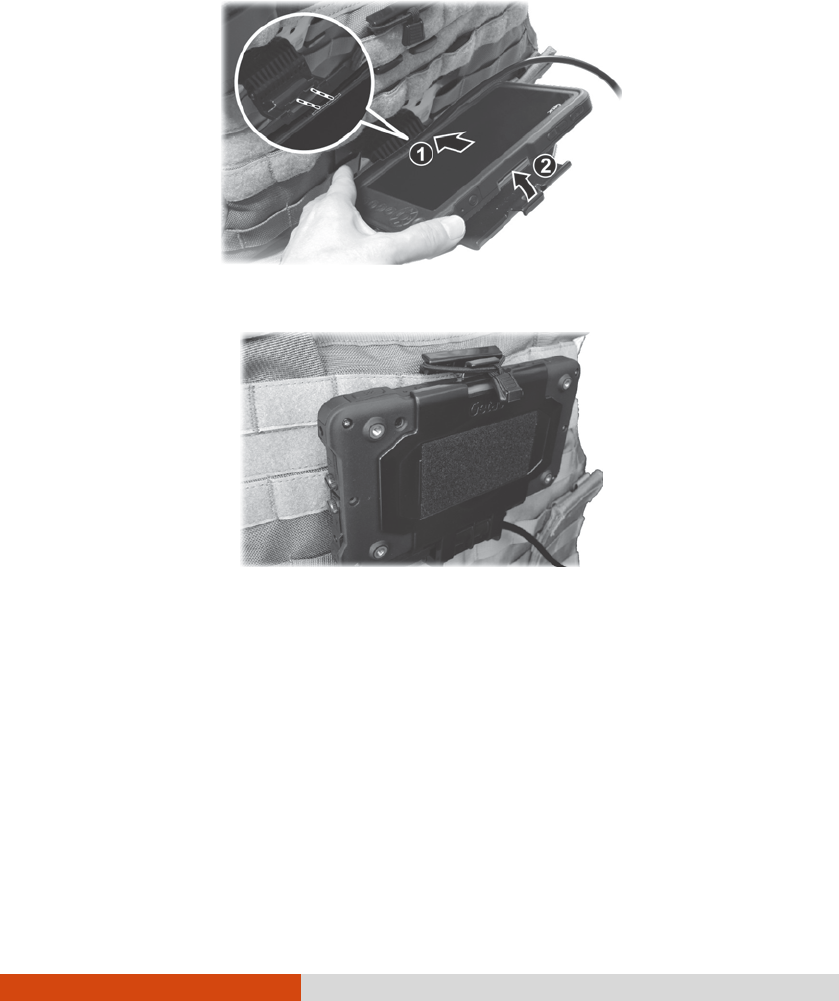
8
4. Align the bottom grooves of MX50 with the counterparts on the mount
and insert MX50 at an angle (). Then press the holder and MX50
together until the clamp clicks into place ().
5. When you flip up the mount, pull the cord over the clamp.
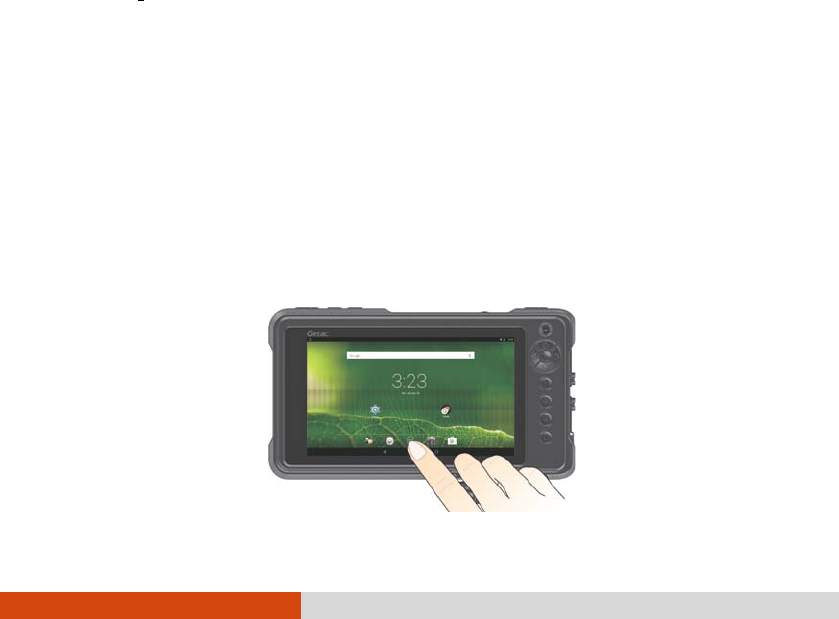
9
Chapter 2
Basic Skills
This chapter familiarizes you with the basic operations of your device.
CAUTION: The device can get uncomfortably warm when you use it in high
temperatures. In such a circumstance, please take safety measures (such as
wearing gloves) to protect yourself. Prolonged body contact can cause
discomfort and potentially a burn.
Sleeping and Shutting Down
You can manually put your device to sleep by briefly pressing the power
button. To wake up, press the power button.
To shut down, press and hold the power button until a menu pops up. Touch
Power off and then OK.
Navigating on the Screen
CAUTION: Do not use sharp objects on the touch screen. Doing so may
damage the display surface.
Use your finger to navigate and select objects on the screen.
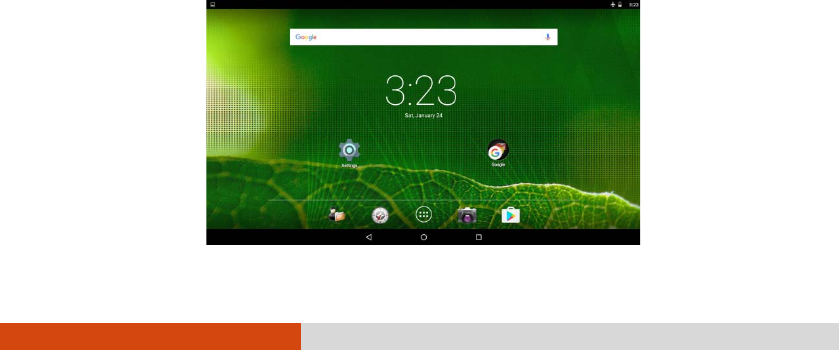
10
Here are some common terms that you should know when using the touch
screen:
Touch
Touch the screen once with your finger to open an item or select an object.
Touch and hold
Touch and hold your finger on an item to see a list of actions available
for that item.
Drag
Hold your finger on an item and, without lifting the finger, move across
the screen until you reach the target position.
Swipe or slide
Move your finger across the screen, without pausing when you first
touch it (so you don’t “drag” instead). For example, you slide the screen
up or down to scroll a list.
Pinch
In some applications (such as Maps and Gallery), you can zoom in and out
by placing two fingers on the screen at once and pinching them together
(to zoom out) or spreading them apart (to zoom in).
Home Screen
The Home screen is your starting point to access all the features on your
device. You can have it display application icons, widgets, shortcuts, and
other features that you want. The default Home screen already contains
some application icons and widgets. At the bottom of every Home screen is
the Favorites tray.
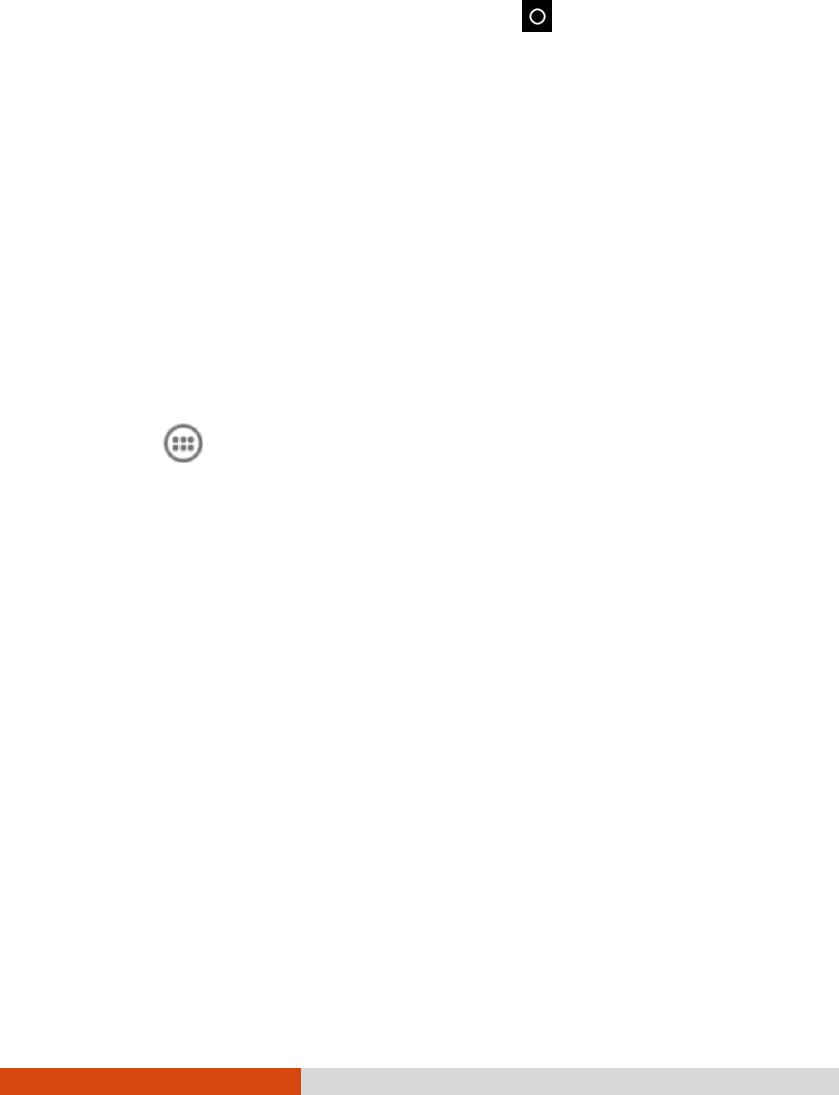
11
To return to the Home screen at any time, touch at the bottom of the
screen or the Home button on the device.
Extensions to the Home Screen
You can slide left or right across the Home screen to see other parts of the
Home screen. Extensions to the Home screen provide more space for
widgets, shortcuts, and other items.
Customizing Your Home Screen
You can add application icons, shortcuts, widgets, and other items to any
part of the Home screen where there’s free space. You can also change the
wallpaper.
Adding an Item to the Home Screen
1. Touch on the Home screen.
2. Touch APPS or WIDGETS depending on the type of item you want to
add.
3. Touch and hold an item to add. Drag it to the where you want to place it
and then release it.
Removing an Item from the Home Screen
Touch and hold the item you want to remove. Drag it to the X icon at the
top of the screen.
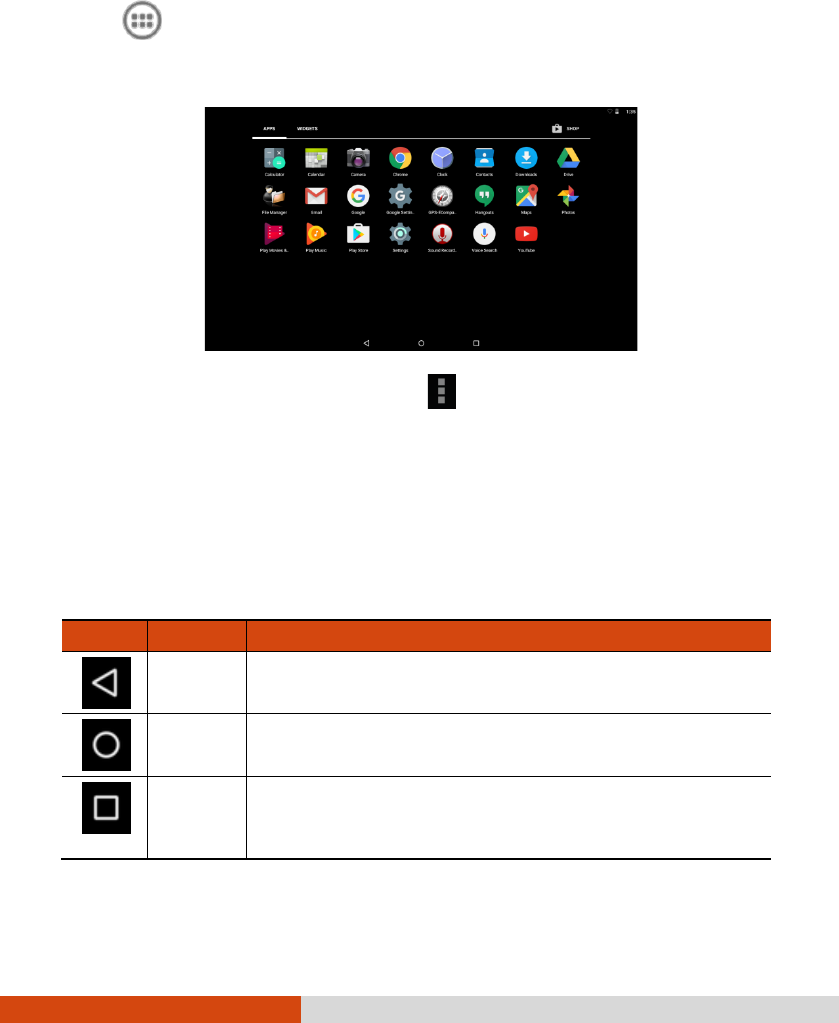
12
Using Applications
Touch (in the Favorites tray) on the Home screen to open the All Apps
screen. The screen holds icons for all of the applications on your device.
Touch an icon to open the application.
Most applications include a Menu icon near the top or lower right corner
of the screen. The menu contains tools that apply to the activities of the
current screen or application.
Navigation Bar
The navigation bar at the bottom of the screen provides buttons for
navigation purposes and frequently-used tasks.
Button Name Description
Back Goes back to the previous screen.
Home Opens the Home screen.
Recent Opens a screen containing thumbnails of applications
you’ve used recently. Touch a thumbnail to open that
application.
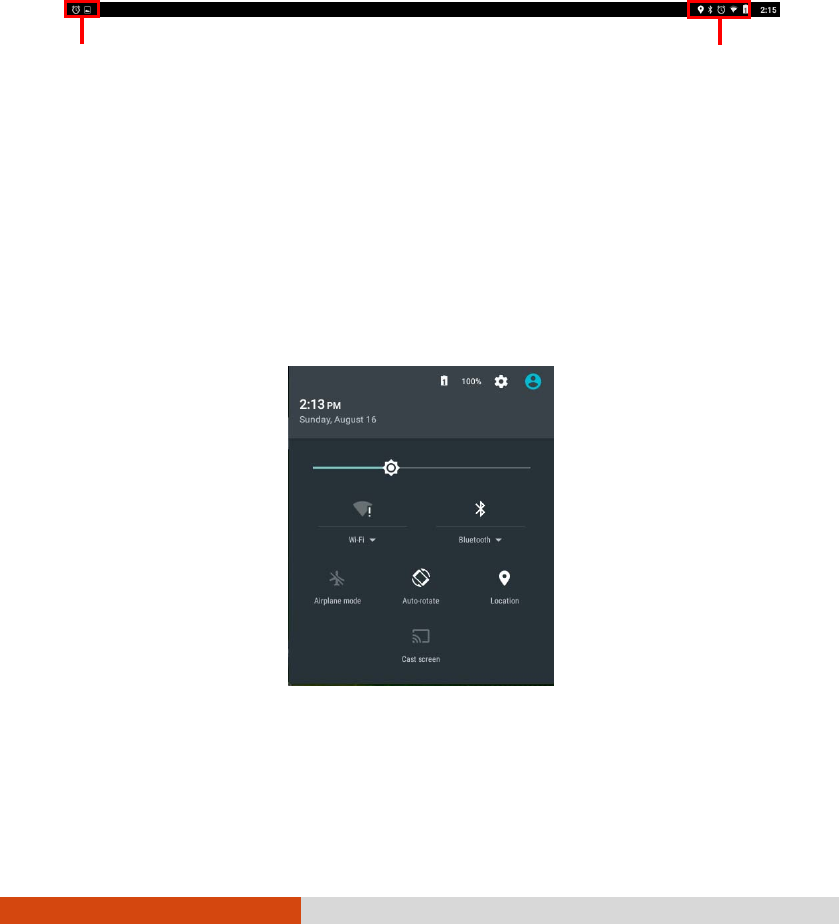
13
Status Bar and Notifications Panel
The Status bar appears at the top of almost every screen. It displays icons
indicating that you’ve received notifications (on the left) and icons
indicating the current status (on the right), along with the current time.
You can open the Notifications panel by swiping down from the top.
Quick Settings
Use Quick Settings to quickly change common settings such as screen
brightness, Wi-Fi, Bluetooth, Airplane mode, and others.
You can open Quick Settings from anywhere on your device. Swipe down
from the top to open the Notifications panel and swipe down again to open
the Quick Settings panel.
Status icons
Notifications icons
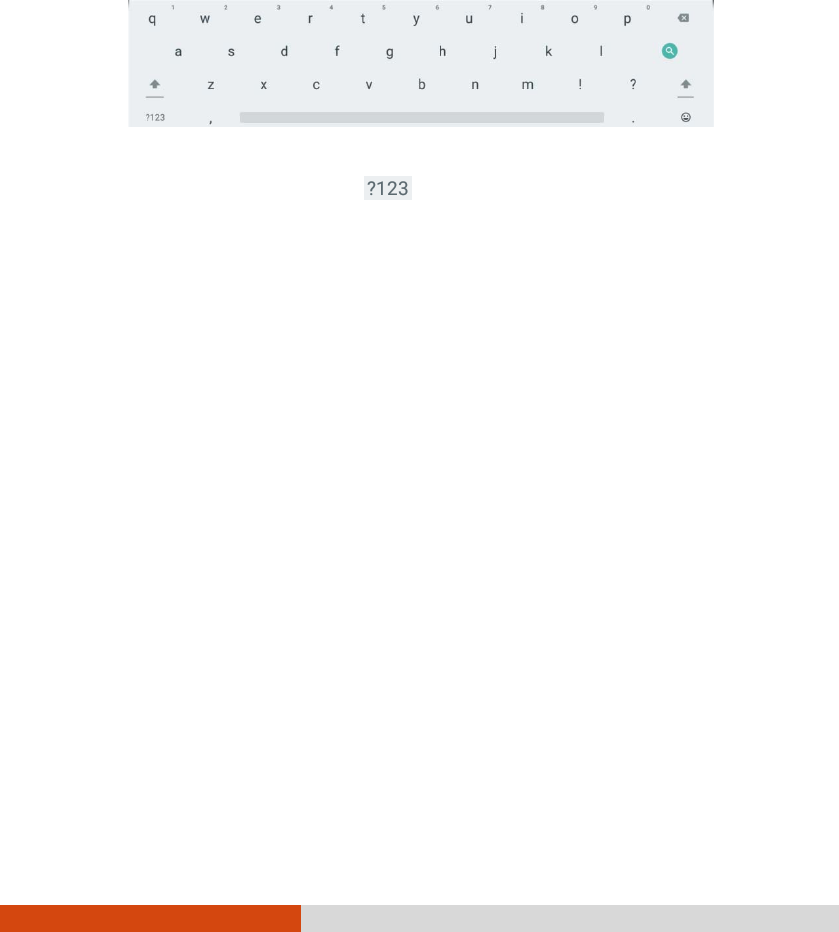
14
Entering Information
You enter text, numbers, and symbols using the onscreen keyboard. Some
applications open the keyboard automatically. In others, you touch an input
field where you want to enter text to open the keyboard.
To enter text, touch the keys on the keyboard to type. To enter numbers or
symbols, touch the Symbols key to switch to the numbers and symbols
keyboard.

15
Chapter 3
Getting Connected
This chapter tells you how you can get your device connected through a
variety of ways.
Wireless Connections
Using Wi-Fi Networks
Turning On/Off the Wi-Fi Radio
Go to Quick Settings and touch the Wi-Fi icon.
- Or –
Go to Settings. Find the Wi-Fi item under WIRELESS & NETWORKS. Slide the
Wi-Fi switch on or off.
When the Wi-Fi radio is turned on, the icon appears in the status bar. If
your device finds a network that you connected to previously, it connects to it.
Connecting to a Wi-Fi Network
1. Make sure the Wi-Fi radio is on (as described in the previous section).
2. Go to Quick Settings and touch the down arrow of the Wi-Fi item.
- Or -
Go to Settings. Touch Wi-Fi.
3. Your device scans for available Wi-Fi networks and displays the names in
the screen.
4. On the list of discovered networks, touch the one you want to connect to.
5. If the network is secured, you’re prompted to enter a password or other
credentials.

16
If the network is open, you are prompted to confirm that you want to
connect to that network by touching Connect
Using the Bluetooth Function
NOTE: Getac does not guarantee the product’s compatibilities with the
Bluetooth headsets/devices from all manufacturers.
Turning On/Off the Bluetooth Radio
Go to Quick Settings and touch the Bluetooth icon.
- Or –
Go to Settings. Find the Bluetooth item under WIRELESS & NETWORKS. Slide
the Bluetooth switch on or off.
When the Bluetooth radio is turned on, the icon appears in the status bar.
Pairing with a Bluetooth Device
The first time you use a new Bluetooth device with your device, you must
“pair” them, so that they know how to connect securely to each other. After
that, you can simply connect to a paired device.
1. Make sure that the other Bluetooth device is set as “discoverable” and
within range.
2. Make sure the Bluetooth radio is on (as described in the previous
section).
3. Go to Quick Settings and touch the down arrow of the Bluetooth item.
- Or -
Go to Settings. Touch Bluetooth.
4. Your device scans for and displays the IDs of all available Bluetooth
devices in range.
5. On the list of discovered devices, touch the ID of the device you want to
pair with.
6. The devices pair with each other. If you’re prompted to enter a passcode,
try entering 0000 or 1234 (the most common passcodes), or consult the
documentation that came with the device to learn its passcode.
If the pairing is successful, your device connects to the device.
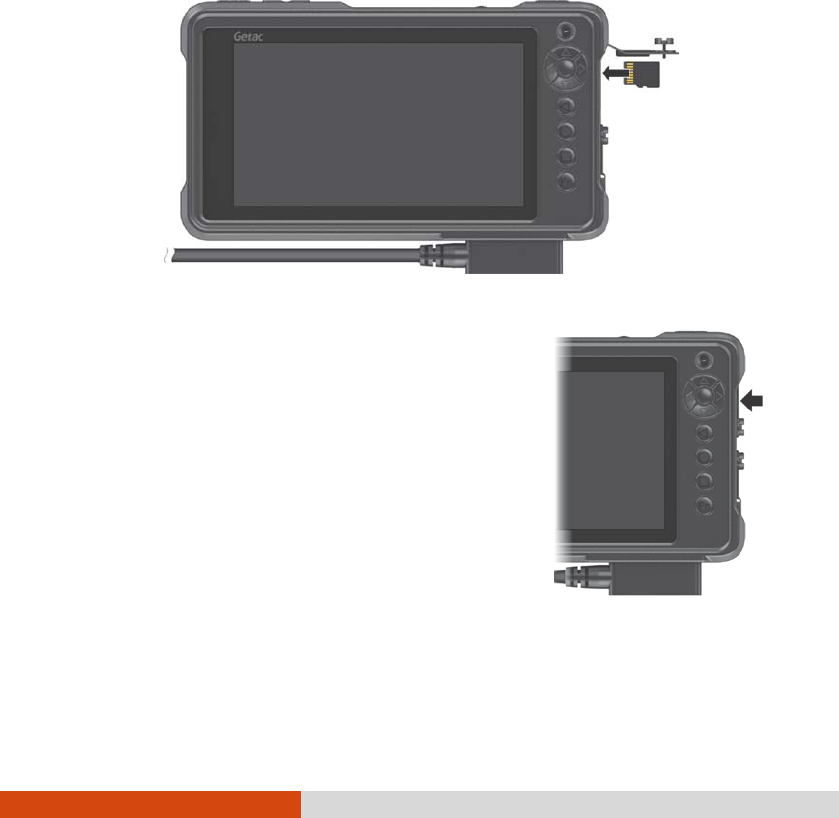
17
External Connections
Using a MicroSD Card
Inserting a MicroSD Card
1. Open the microSD card slot cover by loosening the slotted screw.
2. Insert the card into the slot, with the golden contacts pointing to the slot
and facing front.
3. Close the cover and tighten the screw.
CAUTION: When closing the cover, you must firmly
press all over the cover to ensure its sealing
capability.
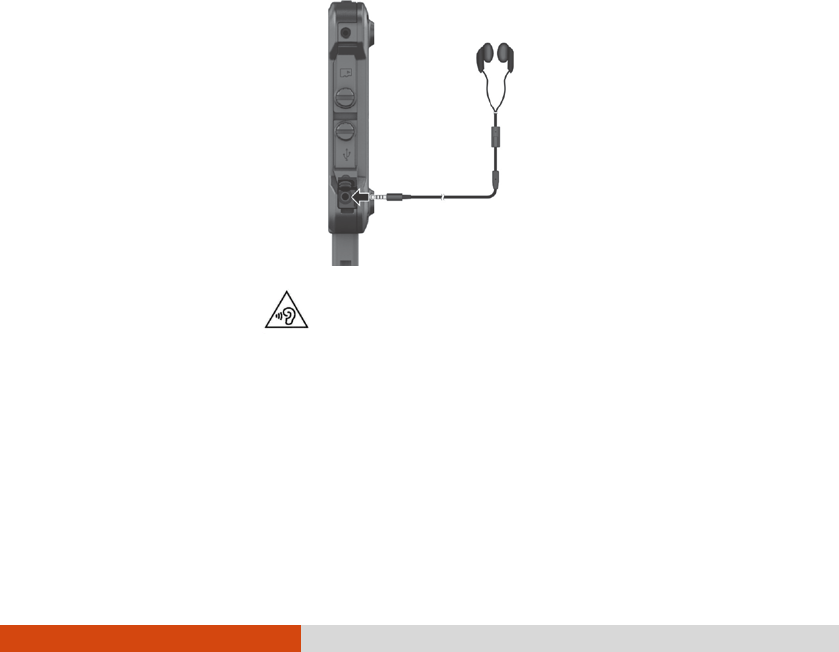
18
Removing MicroSD card
You can safely remove the microSD card from your device any time the
device is shut down. If you need to remove the card while the device is on,
unmount the card first to prevent corrupting or damaging the card.
To unmount:
1. Go to Settings.
2. Touch Storage and touch Unmount SD card under EXTERNAL SD CARD.
3. Open the microSD card slot cover. Press the edge of the card to release it
and then pull the card out of the slot.
Connecting an Audio Device
The audio combo connector is the “4-pole TRRS 3.5mm” type (Apple iPhone
Recessed) so you can connect a compatible headset microphone.
SAFETY WARNING:
To prevent possible hearing damage, do not listen at high volume levels for
long periods.
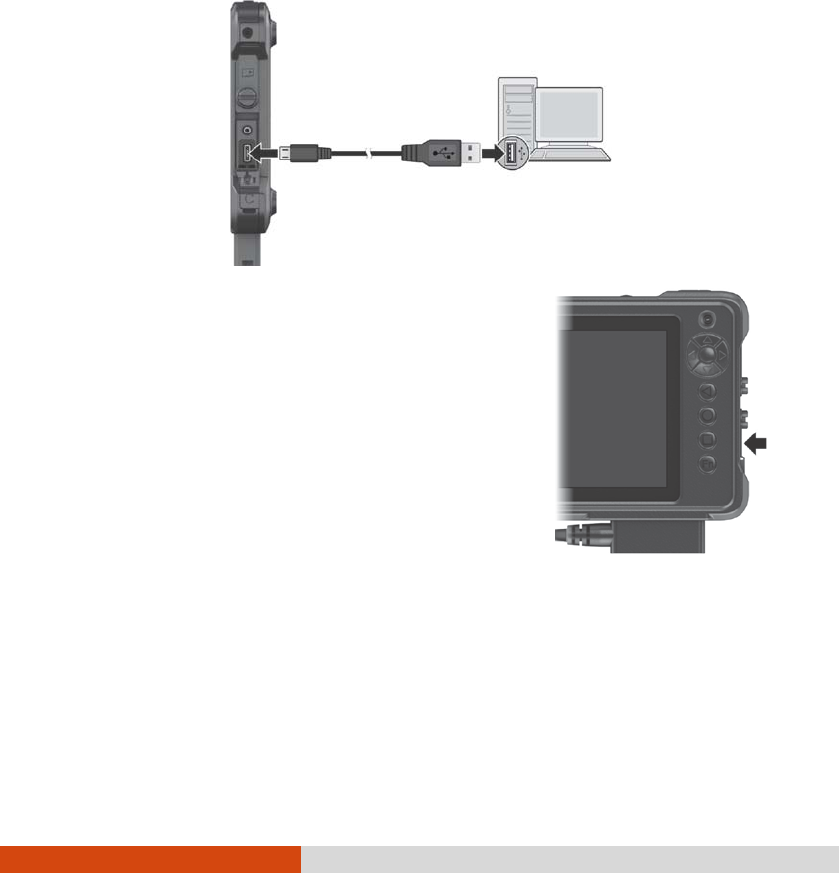
19
Connecting to a Computer via USB
You can connect your device to a computer with the USB cable, to transfer
files between your device and the computer.
1. Open the micro USB connector cover by loosening the slotted screw.
2. Use the USB cable (available to you as an option) to connect the device
to a USB port on your computer.
CAUTION: When closing the cover, you must firmly
press all over the cover to ensure its sealing
capability.
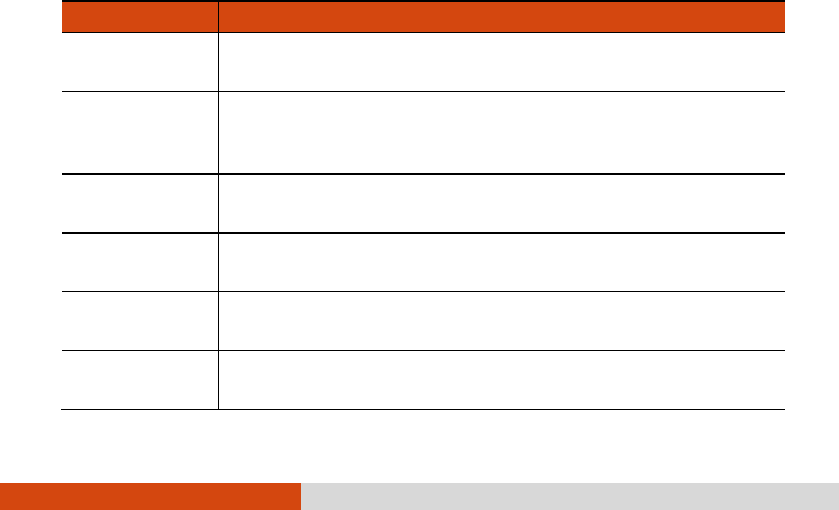
20
Chapter 4
Android Preinstalled
Applications
This chapter briefly introduces the Android 5.1.1 preinstalled applications
from Google.
Google Applications Overview
For instructions on using the Google applications, check Google official
website for online help.
NOTE: The table below does not include Getac applications. See the next
chapter for information on Getac applications.
Apps Descriptions
Calculator Use Calculator to solve arithmetic problems. You can then
paste the results into another application.
Calendar The Calendar app works with the web-based Google
Calendar calendaring service. It also works with the
Microsoft Exchange ActiveSync calendaring service.
Camera Use Camera to take pictures and shoot videos. (See
“Camera” later in this chapter for more information.)
Chrome This is the web browser from Google. Sign in to sync your
Chrome browser experience from your computer
Clock Use Clock to display the date and time in large characters
on your screen.
Contacts The Contacts app gives you quick and easy access to the
people you want to reach.
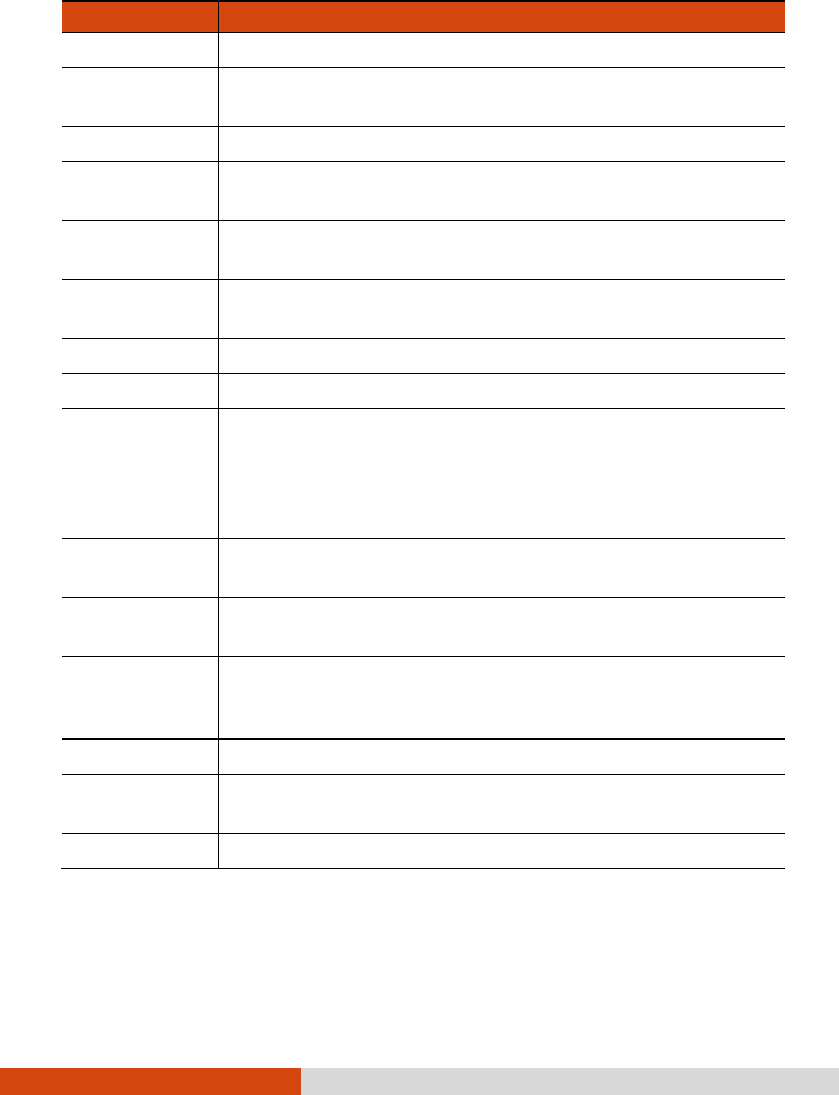
21
Apps Descriptions
Downloads The Downloads app lets you to manage most downloads.
Drive Use Drive to store your files securely in the cloud and also
to access them.
Gmail Gmail works with Google’s web-based email service.
Google Use Google to easily and quickly find what you need on the
web and on your device.
Google
Settings
Use Google Settings to manage settings for Google apps
and services.
Hangouts Use Hangouts to send messages, make voice and video
calls, and share photos.
Maps This is the Google Maps app for Android.
Photos Use Photos to manage photos and videos on your device.
Play Movies &
TV Shows
You can play digital content through the service of Google.
However, the availability of the service depends on your
geographical location. The app icons will disappear from
the screen if you are in a region where the service is
currently unavailable.
Play Music Use Play Music to organize and listen to music and audio
files.
Play Store Use Play Store to get all your applications and
entertainment in one place.
Settings The Settings app contains most of the tools for customizing
and configuring your device. (See “Settings” in Chapter 7
for more information.)
Sound Record This is a tool for recording sound.
Voice Search Use Voice Search to quickly search your device, the web,
and nearby locations by speaking, instead of typing.
YouTube This is the official YouTube app for Android.
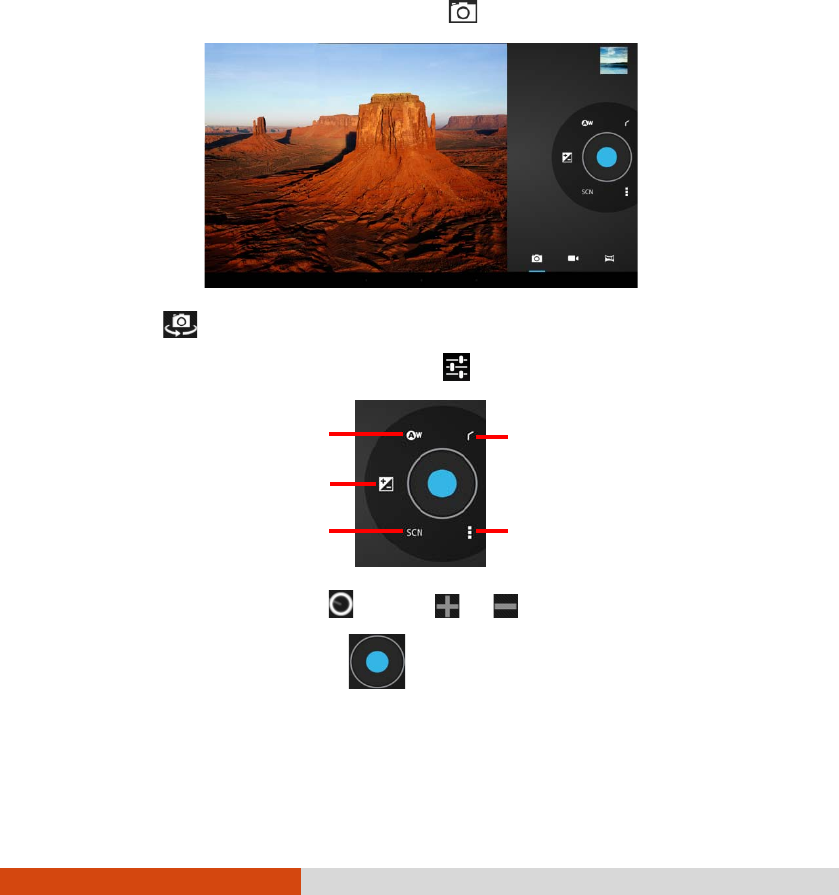
22
Camera
Use the Camera application to take pictures and shoot videos. In addition,
you can have GPS information embedded into the picture/video file.
Taking Pictures
1. Open the Camera application. Touch if you are not in Camera mode.
2. Touch to select the front or rear camera lens.
3. If you want to adjust settings, touch .
4. To zoom in or out, drag toward or .
5. To take the picture, touch .
6. The picture you just took is displayed as a thumbnail at the corner. You
can touch the thumbnail to view the picture.
The file is saved to the internal storage of your device.
Return
White balance
Exposure
Advanced
Scene mode
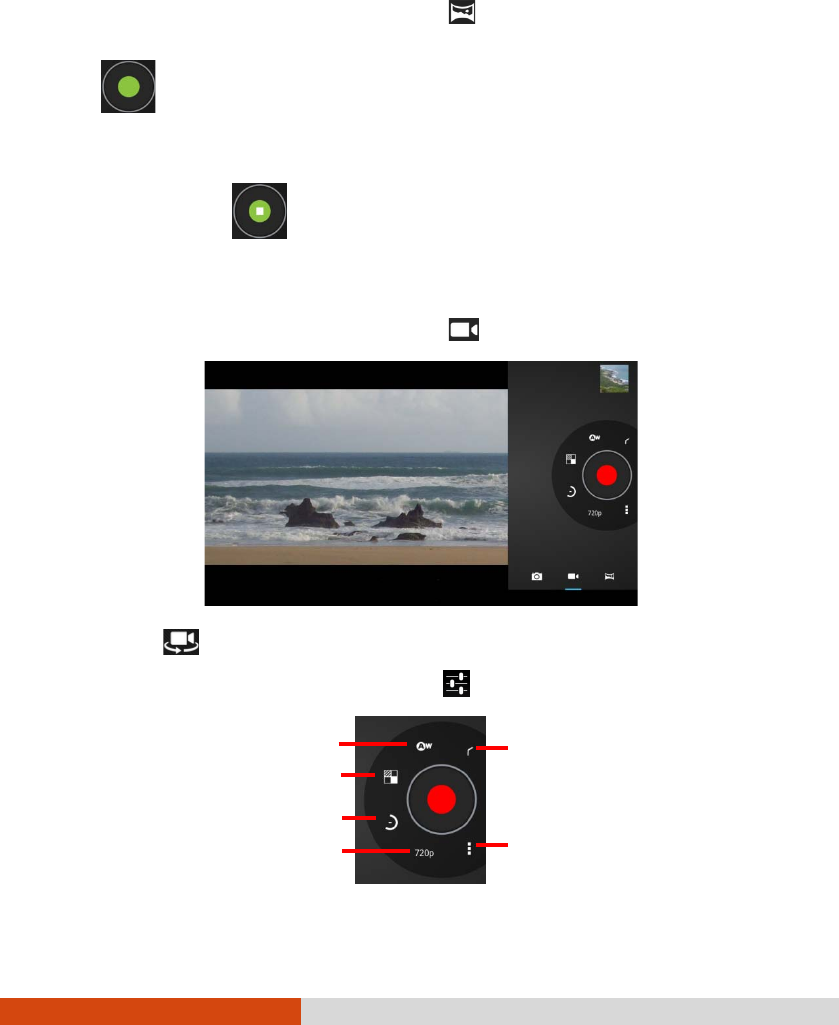
23
Taking Panoramic Pictures
1. Open the Camera application. Touch to switch to Panoramic mode.
2. Aim the camera lens at the starting point of the intended view. Touch
to start.
3. Slowly pan your device toward the other side. The status bar shows your
progress.
4. To end, touch .
Shooting Videos
1. Open the Camera application. Touch to switch to Video mode.
2. Touch to select the front or rear camera lens.
3. If you want to adjust settings, touch .
Return
White balance
Advanced
Time lapse interval
Effects
Video quality
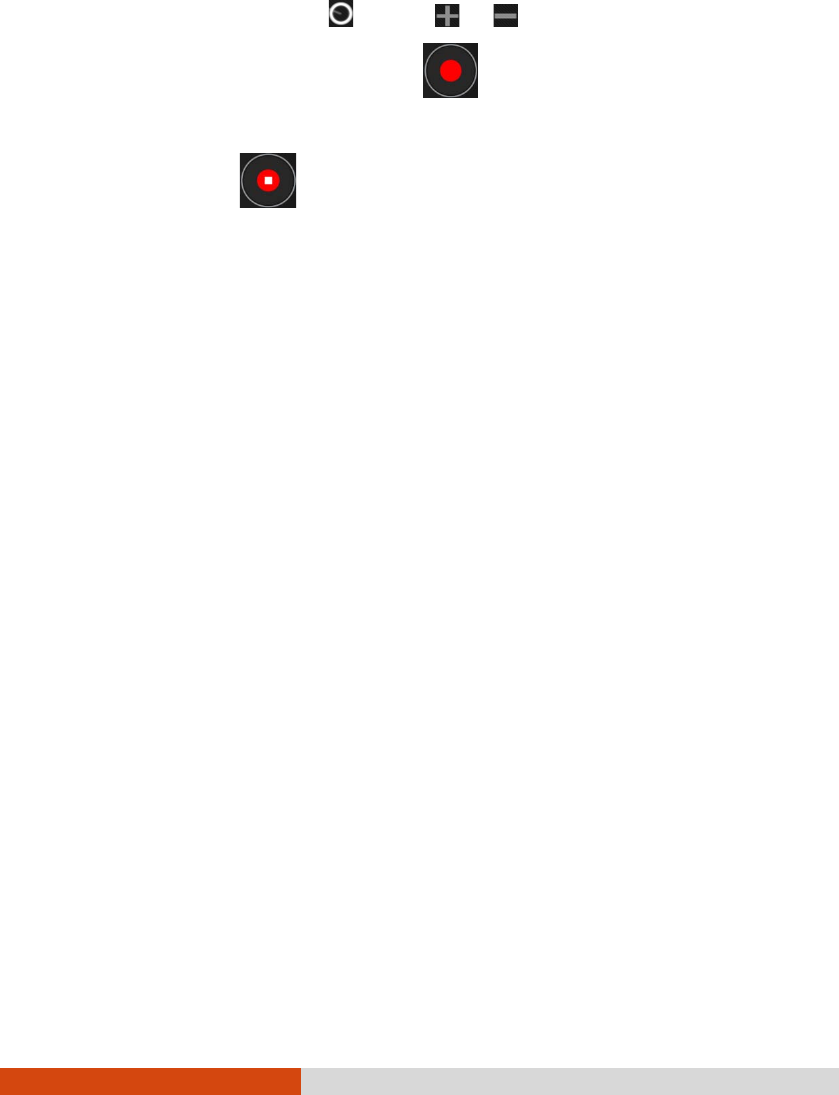
24
4. To zoom in or out, drag toward or .
5. To start shooting the video, touch .
The elapsed time shows at the corner.
6. To stop, touch .
7. An image from your most recent video is displayed as a thumbnail at the
corner. You can touch the thumbnail to view the video.
The file is saved to the internal storage of your device.
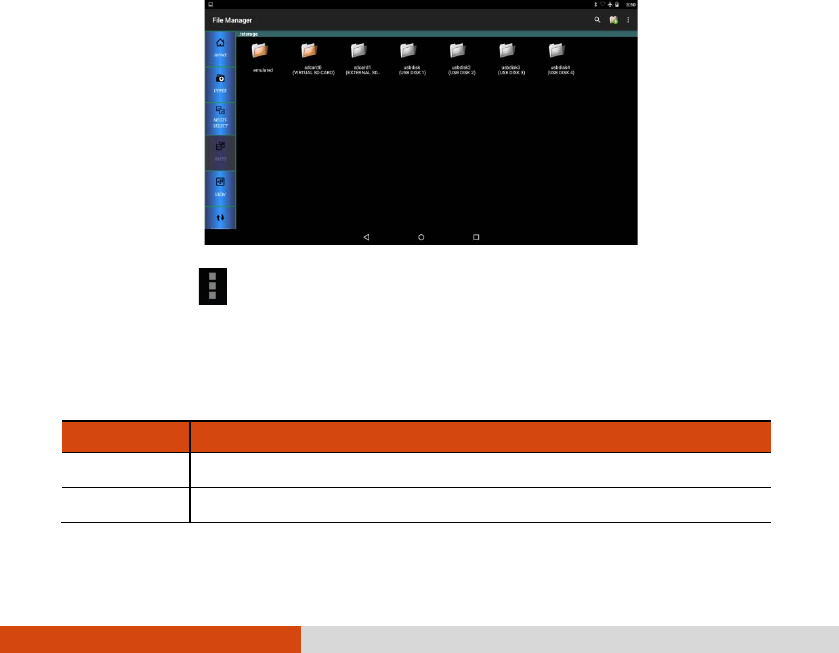
25
Chapter 5
Getac Applications
This chapter describes the applications added by Getac for special features of
your device.
File Manager
File Manager allows you to organize your data in the internal SD card and
any connected external storage (such as a microSD card or USB disk).
To exit, touch Exit.
Button Descriptions
Left side buttons:
Buttons Descriptions
Home Goes to the root directory.
Upper Goes one level up to the parent directory.
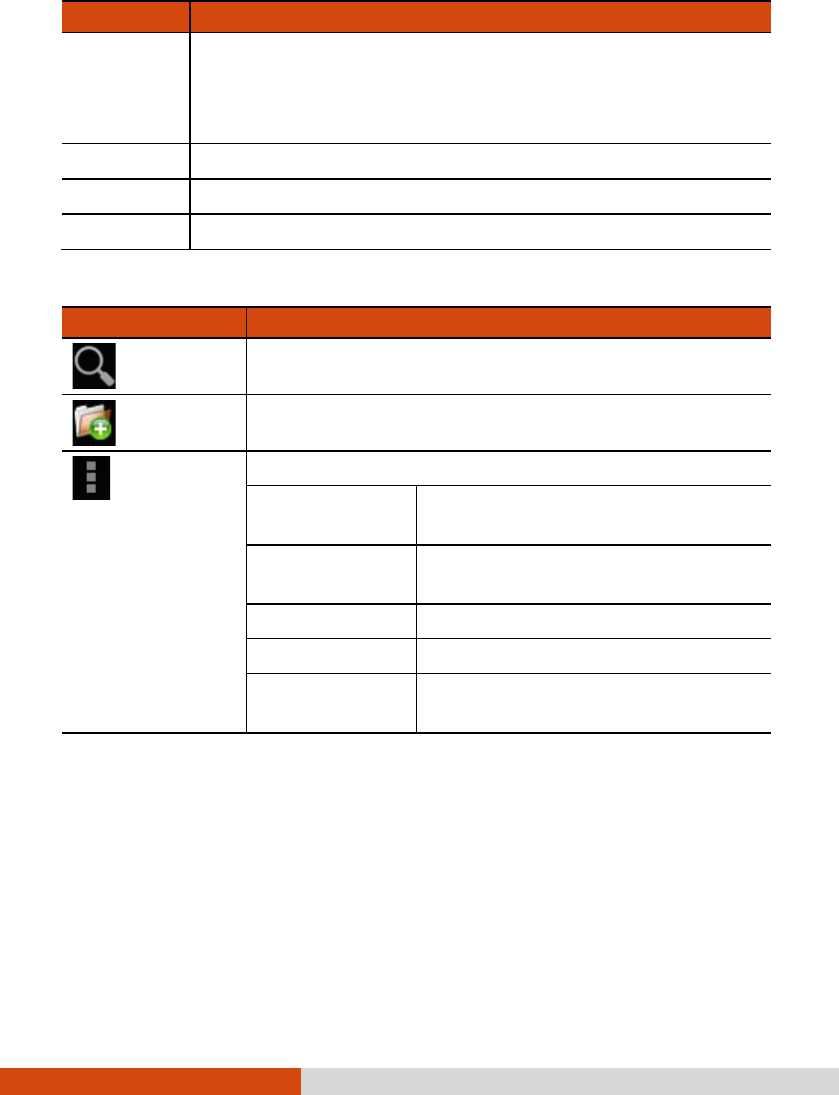
26
Buttons Descriptions
Multi-Select Enables or disables multiple selections.
When enabled, you can touch multiple files or folders for
one batch operation. A set of buttons appear on the left side
of the screen for you to use.
Paste Pastes what you have cut or copied to the current directory.
View Switches between icon and list view.
Refresh Refreshes the current directory.
Upper-right buttons:
Buttons Descriptions
Search Opens the Search box.
Add Folder Adds a folder in the current directory.
Menu Settings
Show all
files/directories
Check to show all files/directories.
Show image
thumbnail(s)
Check to have images shown as
thumbnails.
Display type Sets the view to icon or list view.
Sort by Specifies the sorting order.
Home directory
setting
Specifies a folder as the home
directory in File Manager.
Opening a File
When you touch a filename, File Manager tries to open or execute the file
depending on the file type.
NOTE: Not all files can be opened in this way.
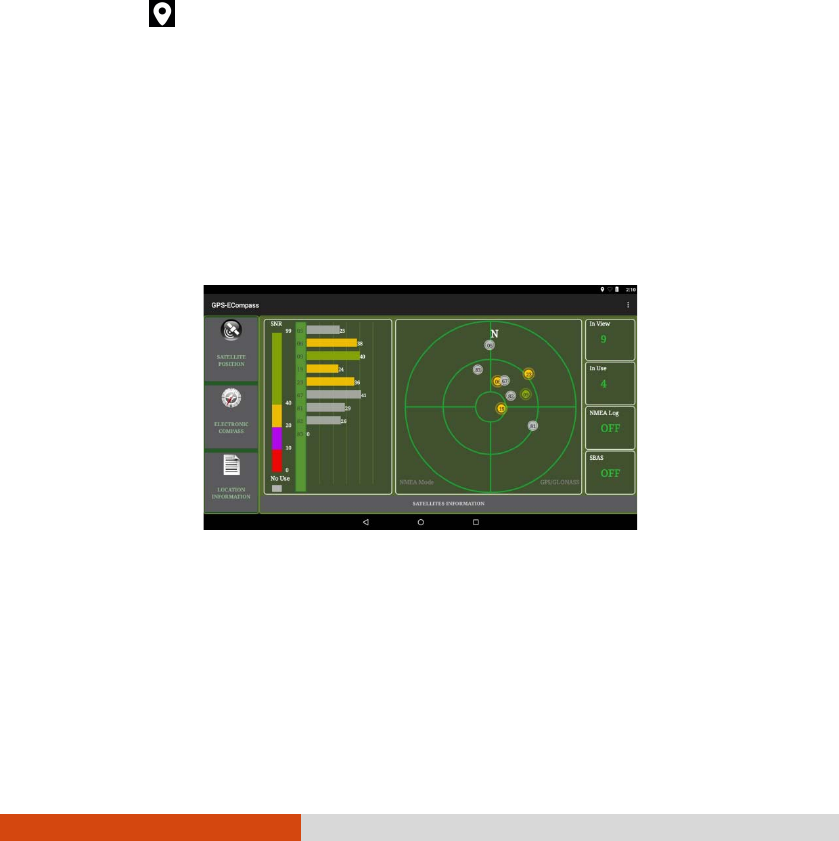
27
GPS-ECompass
GPS-ECompass can:
Function as a compass.
Receive GPS satellite signals to calculate the location of your device.
Record GPS logs.
When opening the application, you will be asked to turn on GPS if it is off.
The icon in the status bar indicates GPS service is in use.
The application has three pages as described later. Touch one of the three
buttons (Satellite Position, Electronic Compass, and Location Information) at
the left side of the screen to see the page.
Satellite Position
The Satellite Position page shows the positions of the overhead satellites
and their signal strength. It also indicates the on/off status of the SBAS and
logging functions.
SBAS (satellite-based augmentation system) provides additional accuracy and
reliability for the GPS devices. Ground stations are necessary to achieve the
purpose. The SBAS feature works where such stations exist. You can enable
the SBAS feature. (See “Getac Settings” in Chapter 7.)
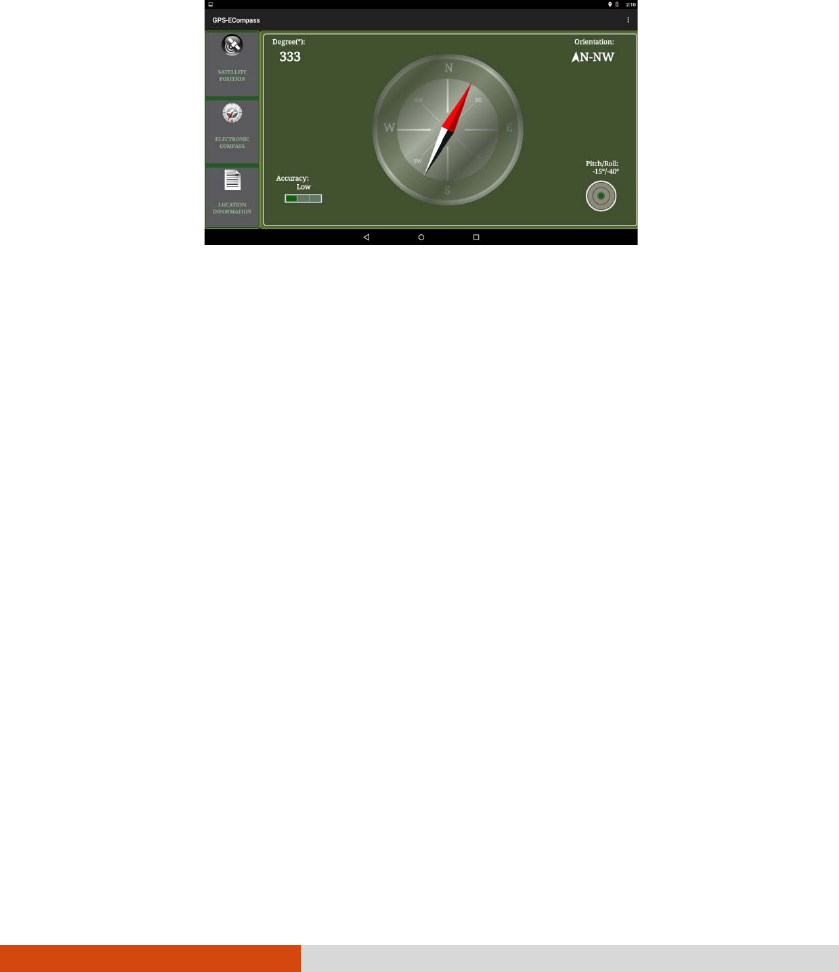
28
Electronic Compass
The Electronic Compass page shows directions of movement including
orientation, pitch angle, roll angle, and azimuth angle.
The Accuracy reading is for your reference. When the application
determines that calibration is needed, it will pop up the “Calibration”
graphics asking you to calibrate the compass. Hold the device and swing it in
the way as shown on the screen. Do this several times until the popup
graphics disappear.
NOTE: Follow these guidelines when using the compass.
Keep the device away from objects that generate magnetic fields, such
as cars, large belt buckles, computers, cell phones, etc.
If you must use the compass inside a car, the device should be at least 20
cm (7.87 inches) away from metal objects such as car doors, dashboard,
air vents, etc.
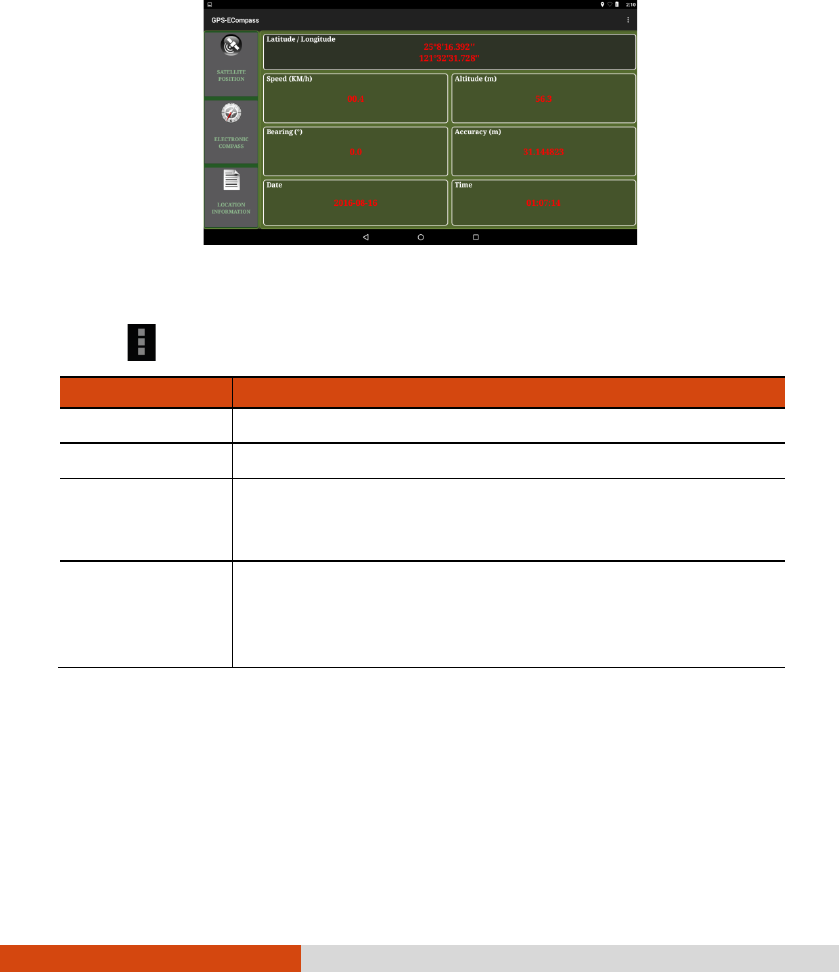
29
Location Information
The Location Information page shows the geographic information of the
current location once GPS positioning is completed.
Settings
Touch and touch Setting.
Items Descriptions
Location Service Check GPS satellites to turn on GPS receiver.
Satellites Log See the next subsection for information.
Rotation Type Set to Needle Compass for a pivoting needle on a fixed
dial or Wheel Compass for a fixed needle on a rotating
dial.
Display Check Calibration to display the Accuracy reading on the
Electronic Compass screen.
Check Balance to display the Pitch/Roll reading on the
Electronic Compass screen.
Touch OK for the changes to take effect.

30
GPS Logging
You can record a GPS log file for the use of other applications. The output
format is NMEA.
1. Touch and touch Setting.
2. Touch Start to write Log in /storage/sdcard0/GpsLog.
3. In the selection menu that pops up, touch .. to accept the default folder
for storing the file.
If you want to specify a different folder, select it in the menu.
4. Touch OK. The recording will continue until you stop it.
5. To stop, touch and touch Setting. Touch Stop to write Log in ….
6. Touch OK.

31
Chapter 6
Managing Your
Device
This chapter tells you how to manage power and configure your device.
Managing Power
The operating time of a fully charged battery depends on how you are using
the device. Some functions, such as using multimedia or operating an SD
card, may consume the battery power considerably.
Low Battery Signals and Actions
CAUTION: When you recharge the battery upon a warning of low power,
you should charge for at least 30 minutes. If you unplug the AC adapter
soon, you may not have sufficient battery power for your operation.
The battery status (charging or discharging) and level (as a percentage of
fully charged) are displayed at the top of the screen. To check the battery
information, go to Settings Battery.
You should save your data and recharge the battery immediately upon a
warning of low power; otherwise your device will turn off automatically.
You need to connect the device to external AC power for charging before
you can use it again.

32
Power-Saving Tips
You can extend your battery’s life between charges by turning off features
that you don’t need. You can also monitor how applications and system
resources consume battery power.
Turn off radios that you aren’t using.
Lower the screen brightness and set a shorter screen timeout.
Lower the volume.
If you don’t need it, turn off automatic syncing for all applications.
Avoid power-consuming applications. To check which applications
consume the most battery power, go to the Home screen, go to Settings
Battery.
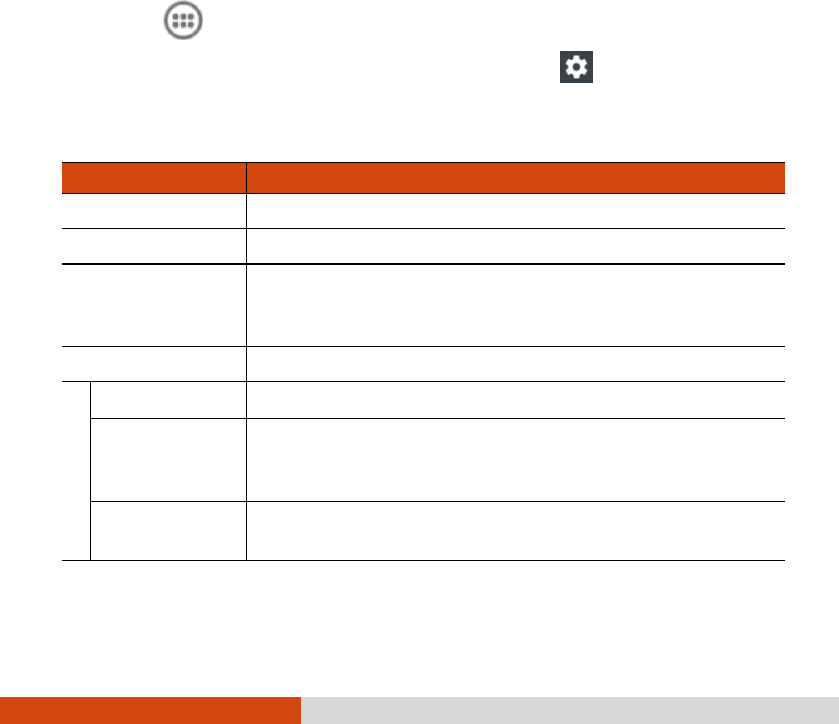
33
Settings
NOTE:
Incorrect settings may cause your system to malfunction. Make sure that
you fully understand the function of a certain item before any adjustment.
Some setting items are available only for specific models or applications
you have in your device.
The Settings application contains most of the tools for customizing and
configuring your device.
To open Settings, use any of the below methods:
Tap the Settings icon in the Home screen.
Touch (on the Home screen) Settings.
Open Quick Settings and touch the Settings icon .
Wireless and Networks Settings
Item Description
Wi-Fi To configure and use Wi-Fi.
Bluetooth To configure and use Bluetooth.
Data usage To view the amount of data uploaded or downloaded
by your device during a given period. You can set up
conditions for data usage.
More…
Airplane mode Check to turns off all wireless radios.
Tethering &
portable
hotspot
To share your device’s mobile data connection via USB
or as a portable Wi-Fi hotspot.
VPN To set the type of VPN to add and view the list of VPNs
that you’ve previously configured.
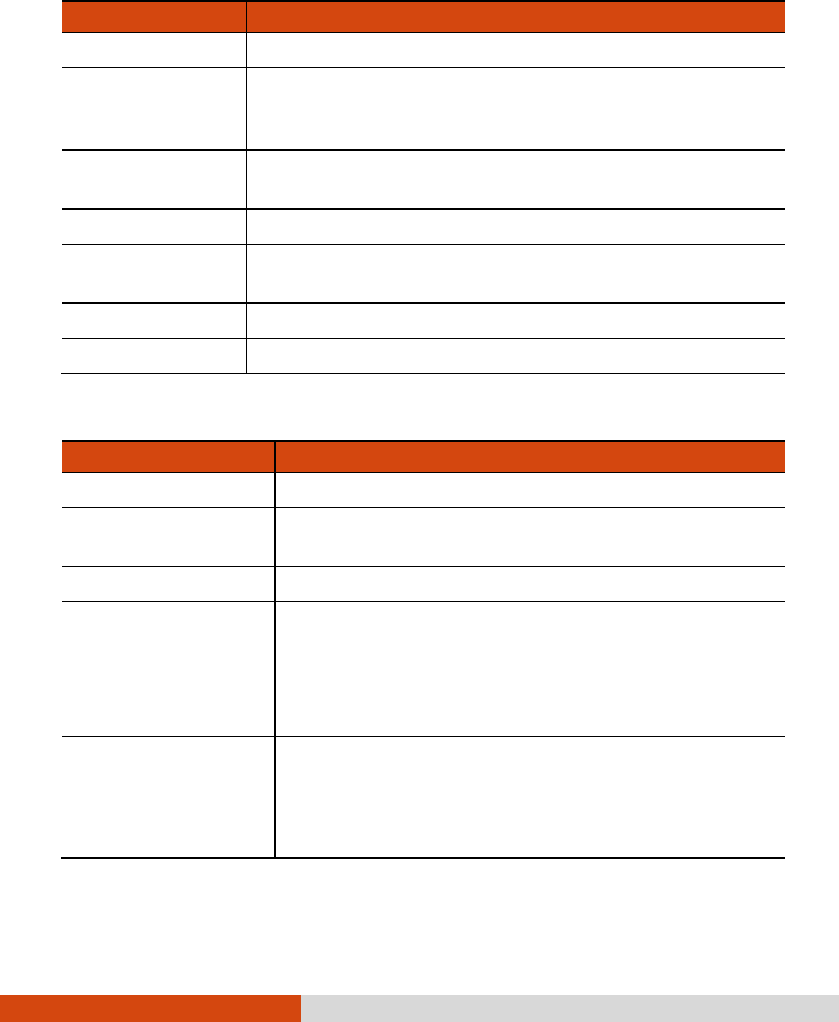
34
Device Settings
Item Description
Display To set brightness, wallpaper, sleep timeout, and font size.
Sound &
notification
To configure sound-related settings such as volume,
phone ringtone, vibration with ringing, notification
sound, etc.
Storage To view the used and available space on your device’s
storage.
Battery To view battery usage data.
Apps To view details about the applications installed on your
device and to manage them.
Users To add, change, or delete users.
Getac settings See below.
Getac Settings
Item Description
Sensors status To view sensors data.
Physical buttons To assign a function or application to a hardware
button on your device.
Night vision To toggle night vision on/off.
Common Criteria To toggle Common Criteria on/off.
“Common Criteria” is an international standard
(ISO/IEC 15408), which define a common framework
for evaluating security features and capabilities of
Information Technology security products.
Global Navigation
Satellite System
To toggle the below functions on/off.
• GPS
• GLONASS
• SBAS
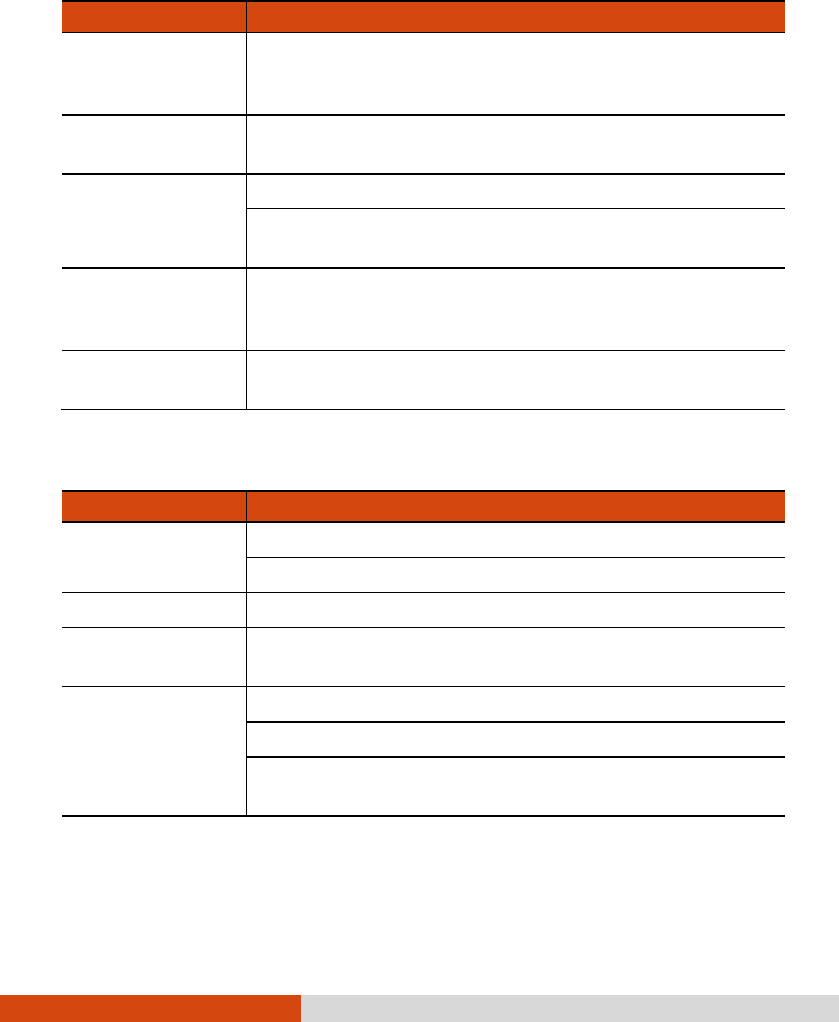
35
Personal Settings
Item Description
Location To configure how you want your device to determine
your location and how you want to share your location
with Google and others.
Security To configure screen lock, power-on password, device
administration, and credential storage.
Accounts To add accounts.
The screen lists the account(s) you have added to the
device. To manage an account, touch it.
Language & input To set up display language, personal dictionary,
keyboard language, input method, voice search, and
text-to-speech output.
Backup & reset To back up data and settings and to reset to factory
default state.
System Settings
Item Description
Date & time To use automatic data and time or to enter manually
To choose data and time format.
Accessibility To modify your device's accessibility settings
Printing To add printing services to your device and to manage
service settings.
About tablet To upgrade your device’s firmware.
To update the system.
To view legal, hardware, and software information of
your device.
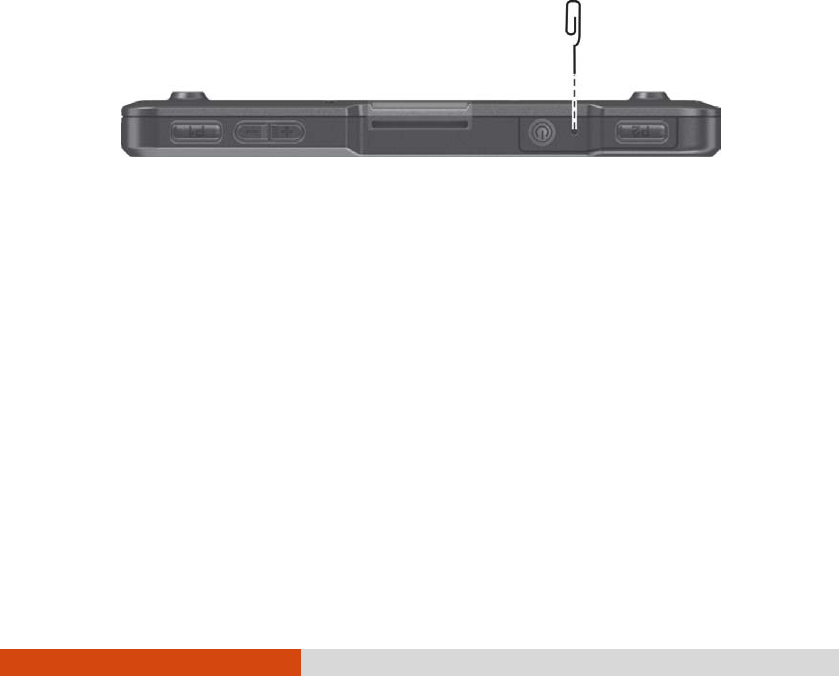
36
Chapter 7
Care and Maintenance
This chapter provides guidelines on taking care of your device.
Resetting Your Device
To restart the device, press and hold the Reset Switch (shown below) for
more than 5 seconds.
Alternatively, you can force the device to power off by pressing and holding
the power button for more than 10 seconds. Then turn it on again.
Caring for Your Device
Taking good care of your device will ensure trouble-free operation and
reduce the risk of damage to your device.
Keep your device away from excessive moisture and extreme
temperatures.
Avoid exposing your device to direct sunlight or strong ultraviolet light
for extended periods of time.
Do not place anything on top of your device or drop objects on your
device.

37
Do not drop your device or subject it to severe shock.
Do not subject your device to sudden and severe temperature changes.
This could cause moisture condensation inside the unit, which could
damage your device. In the event of moisture condensation, allow your
device to dry out completely before use.
The screen surface can easily be scratched. Avoid touching it with sharp
objects. Non-adhesive generic screen protectors designed specifically for
use on portable devices with LCD panels may be used to help protect the
screen from minor scratches.
Never clean your device with it powered on. Use a soft, lint-free cloth to
wipe the screen and the exterior of your device.
Do not use paper towels to clean the screen.
Never attempt to disassemble, repair or make any modifications to your
device. Disassembly, modification or any attempt at repair could cause
damage to your device and even bodily injury or property damage and
will void the warranty.
Do not store or carry flammable liquids, gases or explosive materials in
the same compartment as your device, its parts or accessories.

38
Chapter 8
Regulatory
Information
NOTE: Marking labels located on the exterior of your device indicate the
regulations that your model complies with. Please check the marking labels
on your device and refer to the corresponding statements in this chapter.
Some notices apply to specific models only.
Regulations Statements
USA Class B Regulations
Federal Communications Commission Radio Frequency Interference
Statement
NOTE:
This equipment has been tested and found to comply with the limits for a
Class B digital device pursuant to Part 15 of the FCC Rules. These limits are
designed to provide reasonable protection against harmful interference in a
residential installation. This equipment generates, uses, and can radiate radio
frequency energy and, if not installed and used in accordance with the
instructions, may cause harmful interference to radio communications.
However, there is no guarantee that interference will not occur in a particular
installation. If this equipment does cause harmful interference to radio or
television reception, which can be determined by turning the equipment off
and on, the user is encouraged to try to correct the interference by one or
more of the following measures:
Reorient or relocate the receiving antenna.

39
Increase the separation between the equipment and receiver.
Connect the equipment into an outlet on a circuit different from that to
which the receiver is connected.
Consult the dealer or an experienced radio/TV technician for help.
Any changes or modifications not expressly approved by the manufacturer
could void the user’s authority to operate the equipment.
Please note:
The use of a non-shielded interface cable with this equipment is prohibited.
European Union CE Marking and Compliance
Notices
Statements of Compliance
English
This product follows the provisions of the European Directive 1999/5/EC.
Danish
Dette produkt er i overensstemmelse med det europæiske direktiv
1999/5/EC.
Dutch
Dit product is in navolging van de bepalingen van Europees Directief
1999/5/EC.
Finnish
Tämä tuote noudattaa EU-direktiivin 1999/5/EC määräyksiä.
French
Ce produit est conforme aux exigences de la Directive Européenne
1999/5/EC.
German
Dieses Produkt entspricht den Bestimmungen der Europäischen Richtlinie
1999/5/EC.
Greek
To προϊόν αυτό πληροί τις προβλέψεις της Ευρωπαϊκής Οδηγίας 1999/5/EC.

40
Icelandic
Þessi vara stenst reglugerð Evrópska Efnahags Bandalagsins númer
1999/5/EC.
Italian
Questo prodotto è conforme alla Direttiva Europea 1999/5/EC.
Norwegian
Dette produktet er i henhold til bestemmelsene i det europeiske direktivet
1999/5/EC.
Portuguese
Este produto cumpre com as normas da Diretiva Européia 1999/5/EC.
Spanish
Este producto cumple con las normas del Directivo Europeo 1999/5/EC.
Swedish
Denna produkt har tillverkats i enlighet med EG-direktiv 1999/5/EC.
Restrictions
This device is restricted to indoor use when operating in the 5150 to 5350
MHz frequency range.
Safety Precautions
Prolonged listening of music in maximum volume can damage the ears.
The use of headphones other than those recommended/supplied can
cause hearing impairment due to excessive sound pressure.
Caution for service personnel: Risk of explosion if battery is replaced by
an incorrect type. Dispose of used batteries according to the instructions.
About Charging
Use only the AC adapter supplied with your device. Use of another type
of AC adapter will result in malfunction and/or danger.
Use only the car charger supplied by the manufacturer. Use of another
type of car charger will result in malfunction and/or danger.

41
This product is intended to be supplied by a LISTED Power Unit marked
with “LPS,” “Limited Power Source,” and output rated + 12 V dc / 2.0 A.
Use a specified cradle approved by the manufacturer.
Use a specified battery in the equipment.
About the AC Adapter
Do not use the AC adapter in a high moisture environment. Never touch
the AC adapter when your hands or feet are wet.
Allow adequate ventilation around the AC adapter when using it to
operate the device or charge the battery. Do not cover the AC adapter
with paper or other objects that will reduce cooling. Do not use the AC
adapter while it is inside a carrying case.
Connect the AC adapter to a proper power source. The voltage and
grounding requirements are found on the product case and/or packaging.
Do not use the AC adapter if the cord becomes damaged.
Do not attempt to service the unit. There are no serviceable parts inside.
Replace the unit if it is damaged or exposed to excess moisture.